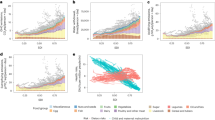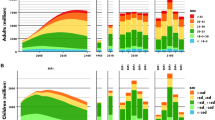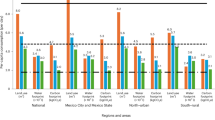Abstract
Environmental implications of food choice are the focus of increasingly extensive research, but less is known about the impacts of dietary patterns of different socio-economic groups of a country, and the trade-offs between nutritional quality and environmental impacts of diet within those groups. We evaluate the impacts of US household dietary patterns on greenhouse gas emissions, blue water footprint, land use and energy consumption across supply chains using an environmentally extended input–output analysis. We compare the nutritional quality of these dietary patterns using healthy eating index scores across individuals’ income and other socio-economic characteristics. Individuals with higher income or education levels are more likely to adopt healthier diets but are also responsible for larger environmental impacts of diet primarily due to a higher consumption of dairy and livestock products, seafood and items with lower energy density but higher nutrient density. Our optimization shows that a healthy diet with lower environmental impacts is achievable within current food budgets for almost 95% of people, and results in average decreases of 2% in food-related greenhouse gas emissions, 24% in land use and 4% in energy consumption, but a 28% increase in blue water consumption. However, such dietary patterns are unaffordable for 38% of Black and Hispanic individuals in the lowest income and education groups. Policies that affect income and food prices making nutritious food more affordable would be needed to achieve better nutrition and improved environmental outcomes simultaneously, particularly for more vulnerable socio-economic groups.
This is a preview of subscription content, access via your institution
Access options





Similar content being viewed by others
Data availability
All the data used in this study are publicly available except the 2015 US input–output table, which can be purchased from IMPLAN and is available upon request due to the data use agreement. The NHANES data can be retrieved from https://www.cdc.gov/nchs/nhanes/index.htm. The Center for Nutrition Policy and Promotion food prices database is available at https://www.fns.usda.gov/resource/cnpp-data. The distribution of cost comes from https://www.bea.gov/industry/industry-underlying-estimates. The FNDDS and FPED databases are available at https://www.ars.usda.gov/northeast-area/beltsville-md-bhnrc/beltsville-human-nutrition-research-center/food-surveys-research-group/docs/. Source data are provided with this paper.
Code availability
The NHANES data were processed using R studio (based on R v3.6.1) and Stata v14.0. The input–output analysis was conducted in MATLAB v2018a. The statistical analysis and the LMDI decomposition were completed in Stata v14.0. The optimization was carried out in MATLAB v2018a. The figures were produced in R studio (based on R v3.6.1). All code is available upon request.
References
Nesheim, M. C., Oria, M. & Yih, P. T. (eds) A Framework for Assessing Effects of the Food System (National Academies Press, 2015).
Ranganathan, J. et al. Shifting Diets for a Sustainable Food Future (World Resources Institute, 2016).
Springmann, M., Godfray, H. C. J., Rayner, M. & Scarborough, P. Analysis and valuation of the health and climate change cobenefits of dietary change. Proc. Natl Acad. Sci. USA 113, 4146–4151 (2016).
Tilman, D. & Clark, M. Global diets link environmental sustainability and human health. Nature 515, 518–522 (2014).
Auestad, N. & Fulgoni, V. L. What current literature tells us about sustainable diets: emerging research linking dietary patterns, environmental sustainability, and economics. Adv. Nutr. 6, 19–36 (2015).
Popkin, B. M., Adair, L. S. & Ng, S. W. Global nutrition transition and the pandemic of obesity in developing countries. Nutr. Rev. 70, 3–21 (2012).
Willett, W. et al. Food in the Anthropocene: the EAT–Lancet Commission on healthy diets from sustainable food systems. Lancet 393, 447–492 (2019).
Dekker, L. H. et al. Socio-economic status and ethnicity are independently associated with dietary patterns: the HELIUS-Dietary Patterns study. Food Nutr. Res. 59, 26317 (2015).
Darmon, N. & Drewnowski, A. Does social class predict diet quality? Am. J. Clin. Nutr. 87, 1107–1117 (2008).
Rehm, C. D., Peñalvo, J. L., Afshin, A. & Mozaffarian, D. Dietary intake among US adults, 1999–2012. JAMA 315, 2542–2553 (2016).
Wang, D. D. et al. Trends in dietary quality among adults in the United States, 1999 through 2010. JAMA Inter. Med. 174, 1587–1595 (2014).
White, R. R. & Hall, M. B. Nutritional and greenhouse gas impacts of removing animals from US agriculture. Proc. Natl Acad. Sci. 114, E10301–E10308 (2017).
Hallström, E., Gee, Q., Scarborough, P. & Cleveland, D. A. A healthier US diet could reduce greenhouse gas emissions from both the food and health care systems. Clim. Change 142, 199–212 (2017).
Heller, M. C., Willits-Smith, A., Meyer, R., Keoleian, G. A. & Rose, D. Greenhouse gas emissions and energy use associated with production of individual self-selected US diets. Environ. Res. Lett. 13, 044004 (2018).
Tom, M. S., Fischbeck, P. S. & Hendrickson, C. T. Energy use, blue water footprint, and greenhouse gas emissions for current food consumption patterns and dietary recommendations in the US. Environ. Syst. Decis. 36, 92–103 (2016).
Rehkamp, S. & Canning, P. Measuring embodied blue water in American diets: an EIO supply chain approach. Ecol. Econ. 147, 179–188 (2018).
Perignon, M., Vieux, F., Soler, L. G., Masset, G. & Darmon, N. Improving diet sustainability through evolution of food choices: review of epidemiological studies on the environmental impact of diets. Nutr. Rev. 75, 2–17 (2017).
Guenther, P. M. et al. Update of the Healthy Eating Index: HEI-2010. J. Acad. Nutr. Diet. https://doi.org/10.1016/j.jand.2012.12.016 (2013).
Dietary Guidelines Advisory Committee. Dietary Guidelines for Americans 2015–2020 (Government Printing Office, 2016).
Liang, S. et al. Socioeconomic drivers of greenhouse gas emissions in the United States. Environ. Sci. Technol. 50, 7535–7545 (2016).
Yu, Y., Feng, K. & Hubacek, K. Tele-connecting local consumption to global land use. Glob. Environ. Change 23, 1178–1186 (2013).
Hoekstra, A. Y. & Mekonnen, M. M. The water footprint of humanity. Proc. Natl Acad. Sci. USA 109, 3232–3237 (2012).
Wu, X. D., Guo, J. L., Meng, J. & Chen, G. Q. Energy use by globalized economy: total-consumption-based perspective via multi-region input–output accounting. Sci. Total Environ. 662, 65–76 (2019).
Heller, M. C. & Keoleian, G. A. Greenhouse gas emission estimates of US dietary choices and food loss. J. Ind. Ecol. 19, 391–401 (2015).
Willits-Smith, A., Aranda, R., Heller, M. C. & Rose, D. Addressing the carbon footprint, healthfulness, and costs of self-selected diets in the USA: a population-based cross-sectional study. Lancet Planet. Health 4, e98–e106 (2020).
Behrens, P. et al. Evaluating the environmental impacts of dietary recommendations. Proc. Natl Acad. Sci. USA 114, 13412–13417 (2017).
Hitaj, C., Rehkamp, S., Canning, P. & Peters, C. J. Greenhouse gas emissions in the United States food system: current and healthy diet scenarios. Environ. Sci. Technol. 53, 5493–5503 (2019).
Kim, D., Parajuli, R. & Thoma, G. J. Life cycle assessment of dietary patterns in the United States: a full food supply chain perspective. Sustainability 12, 1586 (2020).
Birney, C. I., Franklin, K. F., Davidson, F. T. & Webber, M. E. An assessment of individual foodprints attributed to diets and food waste in the United States. Environ. Res. Lett. 12, 105008 (2017).
Rose, D., Heller, M. C., Willits-Smith, A. M. & Meyer, R. J. Carbon footprint of self-selected US diets: nutritional, demographic, and behavioral correlates. Am. J. Clin. Nutr. 109, 526–534 (2019).
Darmon, N. & Drewnowski, A. Contribution of food prices and diet cost to socioeconomic disparities in diet quality and health: a systematic review and analysis. Nutr. Rev. 73, 643–660 (2015).
McNaughton, S. A., Ball, K., Crawford, D. & Mishra, G. D. An index of diet and eating patterns is a valid measure of diet quality in an Australian population. J. Nutr. 138, 86–93 (2008).
Malon, A. et al. Compliance with French nutrition and health program recommendations is strongly associated with socioeconomic characteristics in the general adult population. J. Am. Diet. Assoc. 110, 848–856 (2010).
Lallukka, T., Laaksonen, M., Rahkonen, O., Roos, E. & Lahelma, E. Multiple socio-economic circumstances and healthy food habits. Eur. J. Clin. Nutr. 61, 701 (2007).
Northstone, K. & Emmett, P. Dietary patterns of men in ALSPAC: associations with socio-demographic and lifestyle characteristics, nutrient intake and comparison with women’s dietary patterns. Eur. J. Clin. Nutr. 64, 978–986 (2010).
Harrington, J. et al. Sociodemographic, health and lifestyle predictors of poor diets. Public Health Nutr. 14, 2166–2175 (2011).
Hulshof, K., Brussaard, J., Kruizinga, A., Telman, J. & Löwik, M. Socio-economic status, dietary intake and 10 y trends: the Dutch National Food Consumption Survey. Eur. J. Clin. Nutr. 57, 128 (2003).
Rao, N. D. et al. Healthy, affordable and climate-friendly diets in India. Global Environ. Change 49, 154–165 (2018).
Fisberg, R. M. et al. Dietary quality and associated factors among adults living in the state of São Paulo, Brazil. J. Am. Diet. Assoc. 106, 2067–2072 (2006).
He, P., Baiocchi, G., Hubacek, K., Feng, K. & Yu, Y. The environmental impacts of rapidly changing diets and their nutritional quality in China. Nat. Sustain. 1, 122–127 (2018).
Allcott, H. et al. Food deserts and the causes of nutritional inequality. Q. J. Econ. 134, 1793–1844 (2019).
Hirvonen, K., Bai, Y., Headey, D. & Masters, W. A. Affordability of the EAT–Lancet reference diet: a global analysis. Lancet Glob. Health 8, e59–e66 (2020).
Darmon, N., Lacroix, A., Muller, L. & Ruffieux, B. Food price policies improve diet quality while increasing socioeconomic inequalities in nutrition. Int. J. Behav. Nutr. Phys. Act. 11, 66 (2014).
Swinburn, B. A. et al. The global syndemic of obesity, undernutrition, and climate change: the Lancet Commission report. Lancet 393, 791–846 (2019).
Johnson, D. S., Smeeding, T. M. & Torrey, B. B. Economic inequality through the prisms of income and consumption. Monthly Lab. Rev. 128, 11–24 (2005).
America’s Shrinking Middle Class: a Close Look at Changes within Metropolitan Areas (Pew Research Center, 2016).
Miller, R. E. & Blair, P. D. Input–Output Analysis: Foundations and Extensions (Cambridge Univ. Press, 2009).
Ang, B. W., Zhang, F. & Choi, K.-H. Factorizing changes in energy and environmental indicators through decomposition. Energy 23, 489–495 (1998).
Ang, B. W. LMDI decomposition approach: a guide for implementation. Energy Policy 86, 233–238 (2015).
Bowman, S., Clemens, J., Friday, J., Thoerig, R. & Moshfegh, A. Food Patterns Equivalents Database 2011–12: Methodology and User Guide (USDA, 2014).
Trumbo, P., Schlicker, S., Yates, A. A. & Poos, M. Dietary reference intakes for energy, carbohydrate, fiber, fat, fatty acids, cholesterol, protein and amino acids. J. Am. Diet. Assoc. 102, 1621–1630 (2002).
Macdiarmid, J. & Blundell, J. Assessing dietary intake: who, what and why of under-reporting. Nutr. Res. Rev. 11, 231–253 (1998).
Dodd, K. W. et al. Statistical methods for estimating usual intake of nutrients and foods: a review of the theory. J. Am. Diet. Assoc. 106, 1640–1650 (2006).
Zhang, S. et al. A new multivariate measurement error model with zero-inflated dietary data, and its application to dietary assessment. Ann. Appl. Stat. 5, 1456–1487 (2011).
Tooze, J. A. et al. A mixed-effects model approach for estimating the distribution of usual intake of nutrients: the NCI method. Stat. Med. 29, 2857–2868 (2010).
Freedman, L. S., Guenther, P. M., Krebs-Smith, S. M., Dodd, K. W. & Midthune, D. A population’s distribution of Healthy Eating Index-2005 component scores can be estimated when more than one 24-hour recall is available. J. Nutr. 140, 1529–1534 (2010).
Lenzen, M., Kanemoto, K., Moran, D. & Geschke, A. Mapping the structure of the world economy. Environ. Sci. Technol. 46, 8374–8381 (2012).
Rodrigues, J. F. D., Moran, D., Wood, R. & Behrens, P. Uncertainty of consumption-based carbon accounts. Environ. Sci. Technol. 52, 7577–7586 (2018).
Lenzen, M., Wood, R. & Wiedmann, T. Uncertainty analysis for multi-region input–output models—a case study of the UK’s carbon footprint. Econ. Syst. Res. 22, 43–63 (2010).
Acknowledgements
This work was supported by the National Natural Science Foundation of China under a Young Scholar Program Grant (71904098) and the China Postdoctoral Science Foundation under a Chinese Postdoc Scientific Grant (2019M650704).
Author information
Authors and Affiliations
Contributions
P.H., K.F. and G.B. designed the study. P.H. prepared the data and led the analysis. P.H. and G.B. drew the figures. All authors participated in discussing the results and contributed to writing the manuscript.
Corresponding authors
Ethics declarations
Competing interests
The authors declare no competing interests.
Additional information
Peer review information Nature Food thanks Gregory Miller, Laura Pereira and Donald Rose for their contribution to the peer review of this work.
Publisher’s note Springer Nature remains neutral with regard to jurisdictional claims in published maps and institutional affiliations.
Supplementary information
Supplementary Information
Supplementary methods and data description, Figs. 1–11 and Tables 1–19.
Supplementary Data
Statistical source data for Supplementary Figs. 2–11.
Source data
Source Data Fig. 1
Statistical source data.
Source Data Fig. 2
Statistical source data.
Source Data Fig. 3
Statistical source data.
Source Data Fig. 4
Statistical source data.
Source Data Fig. 5
Statistical source data.
Source Data Fig. 5
Statistical source data.
Rights and permissions
About this article
Cite this article
He, P., Feng, K., Baiocchi, G. et al. Shifts towards healthy diets in the US can reduce environmental impacts but would be unaffordable for poorer minorities. Nat Food 2, 664–672 (2021). https://doi.org/10.1038/s43016-021-00350-5
Received:
Accepted:
Published:
Issue Date:
DOI: https://doi.org/10.1038/s43016-021-00350-5
This article is cited by
-
Reducing climate change impacts from the global food system through diet shifts
Nature Climate Change (2024)
-
Adopting agronomic strategies to enhance the adaptation of global rice production to future climate change: a meta-analysis
Agronomy for Sustainable Development (2024)
-
Carbon footprint and embodied nutrition evaluation of 388 recipes
Scientific Data (2023)
-
Critical Analysis of Demographic Data Based on ISO/IEC 17,025 Standard for the Regionalization of Brazilian Anthromes
MAPAN (2023)
-
Dietary environmental impacts of French adults are poorly related to their income levels or food insecurity status
European Journal of Nutrition (2023)



